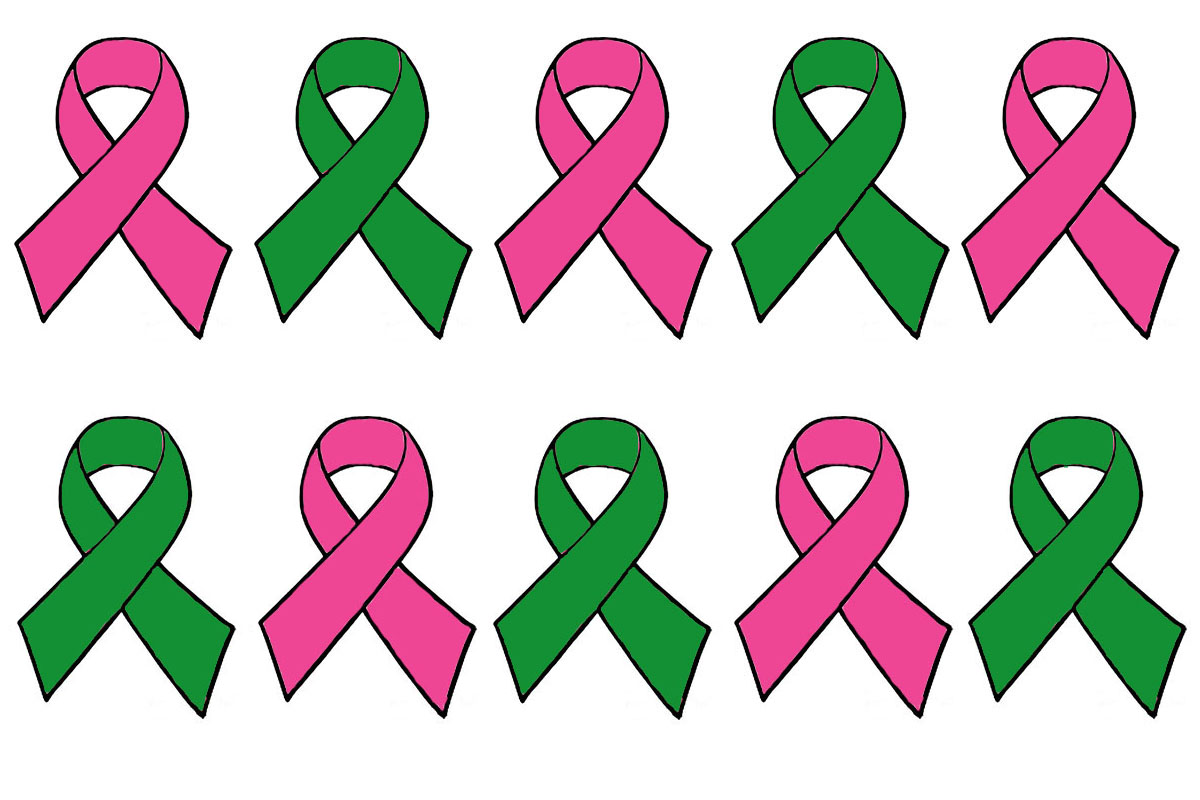October is Breast Cancer Awareness Month. Do You Know When Liver Cancer Month Is?

Breast and Liver Cancer Awareness Ribbons/Graphic by Hallie Smith
When October rolls around, out come the pumpkins, costumes, and bags of candy. But among the black and orange are patches of pink.
October is Breast Cancer Awareness month. And because the color pink has become synonymous with breast cancer awareness, everything, from the NFL to Campbell soup cans, turns pink in its observance.
You likely already knew all of that. What you probably don’t know, however, is that October is also Liver Cancer Awareness Month. In fact, every month, besides August and December, has been designated as a cancer awareness month. So why does breast cancer have far and away the most the mainstream recognition?
It may be how common it is. The National Cancer Institute estimates that, this year, roughly 246,660 women will be diagnosed with breast cancer. The next most common disease, lung cancer, will have an estimated 224,000 new diagnoses this year, but the numbers drop way off after that. Liver cancer, for example, will see an estimated 39,230 new cases.
Still, Tom Nealon, CEO of the American Liver Foundation, says liver cancer is more common than the average person realizes—it’s just not talked about.
“People don’t talk about liver cancer, and they should,” Nealon says.
That silence, Nealon explains, can lead to later diagnoses, and higher mortality rates. According to data from the Surveillance, Epidemiology, and End Results Program, in the United States, a person’s chance of surviving breast cancer for more than five years is 89.7 percent. With liver cancer, it’s 17.5 percent.
Because breast cancer is the most common type of cancer, and has a survival rate close to 90 percent, there are more survivors who can talk about their experiences. When cancers are not as common or have higher mortality rates, there are fewer people around to talk about it.
Suzanne Wedel, who was an ovarian cancer activist before succumbing to the disease this spring, experienced that phenomenon first-hand. She told Boston last year that ovarian cancer has very few champions, because women are often diagnosed late in life and at late stages of the disease. “There’s really nobody that’s advocating for this disease because, candidly, it’s all metastatic and people aren’t in very good shape when they get this diagnosis,” she said.
When there are more people with a certain type of cancer, there are more people talking about it, which means a cancer campaign may gain traction—something Nealon thinks will eventually happen with liver cancer.
“I think with the continued increase in the number of cases of liver cancer, it’s unfortunately inevitable that there will be more discussion around it,” he says.
Discussion stalls now, Nealon says, in part because of stigma.
Some of liver cancer’s major risk factors—hepatitis B and C, heavy drinking, obesity, and type 2 diabetes—may be sources of shame for patients. It’s a misconception, Nealon says, that liver cancer and liver disease are solely based on lifestyle.
“That [misconception] validates that we have a lot of work to do to make sure that we de-stigmatize all forms of liver disease,” Nealon says. “That’s essential for people coming forward, getting detection of whatever the disease might be, but then, more importantly, getting treated.”
Ironically, a similar stigma used to surround breast cancer.
“One of the big contributions that Susan G. Komen made early on in its evolution was to just get people to say the words ‘breast cancer,'” Lori van Dam, CEO for Susan G. Komen of Southern New England, says. “I think our organization, from the beginning, has been trying to make cancer, and specifically breast cancer, something you can talk about, because if you can’t talk about it, you can’t help people.”
Van Dam says the organization is now more focused on educating the public and taking action against breast cancer, rather than simply raising awareness. Its “More Than Pink” campaign spotlights researchers, volunteers, and patient coordinators who are fighting to eliminate breast cancer.
“Awareness is a word that people really struggle with,” van Dam says. “For us it’s about education, and there is still an enormous amount of education that needs to happen.”
One reason breast cancer education and awareness has succeeded thus far is the cancer’s personal reach. “Everyone has a sister or a mother or an aunt or a cousin who’s been affected. I think the fact that it’s a very common cancer”—one in eight women will be diagnosed with breast cancer in her lifetime—”means that it affects people personally.”
Eric Winer, director of the breast oncology program at Dana-Farber, says that in addition to the ubiquity of breast cancer, a breast cancer diagnosis affects people other than the patient.
“[Breast cancer] affects [a woman’s] entire family—her partner, her children, her parents—and given the impact of breast cancer, I don’t think it’s surprising that awareness campaigns have a certain staying power,” Winer says.
He also says that breast cancer campaigns have succeeded because it’s a disease about which “we have learned a great deal,” so people may feel that initiatives are actually affecting change.
Liver cancer hasn’t had those research breakthroughs, and doesn’t have the range of treatment options that breast cancer does, which makes early detection and treatment imperative, Nealon says.
And when people take that initiative, Nealon wants them to be celebrated in the way that patients who overcome breast cancer are.
“It would be so wonderful if we could get to the point that people celebrate liver cancer survivors, because if they’ve survived, it’s probably because they took a great initiative to say, ‘I think I might be at risk,'” Nealon says. “[They said,] ‘I don’t want to wait until it’s too late, so I’m going make sure by going to my physician and have them conduct whatever tests may be necessary.'”


